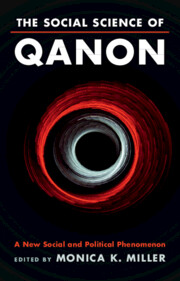Book contents
- The Social Science of QAnon
- The Social Science of QAnon
- Copyright page
- Dedication
- Contents
- Contributors
- Preface
- Part I Introduction to QAnon
- Part II Recruiting and Maintaining Followers
- Chapter 2 Down the Conspiracy Theory Rabbit Hole
- Chapter 3 Psychological Motives of QAnon Followers
- Chapter 4 Cognitive Processes, Biases, and Traits That Fuel QAnon
- Chapter 5 The Role of Moral Cognitions in the Growth of QAnon
- Chapter 6 Emotions and the QAnon Conspiracy Theory
- Chapter 7 Recruitment to QAnon
- Part III QAnon and Society
- Part IV The Role of Communication in Promoting and Limiting QAnon Support
- Part V The Future of QAnon
- Index
- References
Chapter 4 - Cognitive Processes, Biases, and Traits That Fuel QAnon
from Part II - Recruiting and Maintaining Followers
Published online by Cambridge University Press: 14 September 2023
- The Social Science of QAnon
- The Social Science of QAnon
- Copyright page
- Dedication
- Contents
- Contributors
- Preface
- Part I Introduction to QAnon
- Part II Recruiting and Maintaining Followers
- Chapter 2 Down the Conspiracy Theory Rabbit Hole
- Chapter 3 Psychological Motives of QAnon Followers
- Chapter 4 Cognitive Processes, Biases, and Traits That Fuel QAnon
- Chapter 5 The Role of Moral Cognitions in the Growth of QAnon
- Chapter 6 Emotions and the QAnon Conspiracy Theory
- Chapter 7 Recruitment to QAnon
- Part III QAnon and Society
- Part IV The Role of Communication in Promoting and Limiting QAnon Support
- Part V The Future of QAnon
- Index
- References
Summary
Much effort has been spent trying to determine who ‘Q’ is, yet little is known about the characteristics of who follows ‘Q’ and QAnon. This chapter discusses the cognitive processes, cognitive biases, and traits (e.g., beliefs and individual characteristics) possibly associated with QAnon followers. Cognitive processes such as delusional ideation, teleological thinking, cognitive closure, and Pierre’s (2020) socio-epistemic model are examined in the context of QAnon followers, along with a variety of cognitive biases (e.g., groupthink, confirmation bias, jumping to conclusions bias). Additionally, traits such as being racist (e.g., holding anti-Black and anti-Semitic attitudes), narcissism, Machiavellianism, and political affiliations are possible common traits among QAnon followers. A brief discussion of how QAnon is similar or different from other groups (e.g., conspiracy or religious groups) is offered, along with some research questions for future study about QAnon specifically. This understanding is crucial, especially as QAnon followers are gaining political power and agency.
- Type
- Chapter
- Information
- The Social Science of QAnonA New Social and Political Phenomenon, pp. 49 - 67Publisher: Cambridge University PressPrint publication year: 2023



